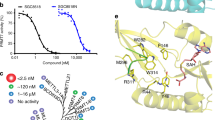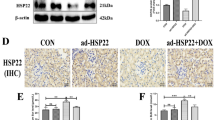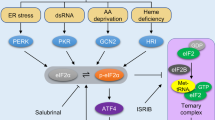Abstract
Preservation of the chemical architecture of a cell or of an organism under changing and perhaps stressful conditions is termed homeostasis. An integral feature of homeostasis is the rapid expression of genes whose products are specifically dedicated to protect cellular functions against stress. One of the best known mechanisms protecting cells from various stresses is the heat-shock response which results in the induction of the synthesis of heat-shock proteins (HSPs or stress proteins)1–3. A large body of information supports that stress proteins — many of them molecular chaperones4–8 — are crucial for the maintenance of cell integrity during normal growth as well as during patho-physiological conditions9–11, and thus can be considered “homeostatic proteins.” Recently emphasis is being placed on the potential use of these proteins in preventing and/or treating diseases12–14. Therefore, it would be of great therapeutic benefit to discover compounds that are clinically safe yet able to induce the accumulation of HSPs in patients with chronic disorders such as diabetes mellitus, heart disease or kidney failure. Here we show that a novel cytoprotective hydroxylamine derivative, [2-hydroxy-3-(1-piperidinyl) propoxy]-3-pyridinecarboximidoil-chloride maleate, Bimoclomol15, facilitates the formation of chaperone molecules in eukaryotic cells by inducing or amplifying expression of heat-shock genes. The cytoprotective effects observed under several experimental conditions, including a murine model of ischemia and wound healing in the diabetic rat, are likely mediated by the coordinate expression of all major HSPs. This nontoxic drug, which is under Phase II clinical trials, has enormous potential therapeutic applications.
This is a preview of subscription content, access via your institution
Access options
Subscribe to this journal
Receive 12 print issues and online access
$209.00 per year
only $17.42 per issue
Buy this article
- Purchase on SpringerLink
- Instant access to full article PDF
Prices may be subject to local taxes which are calculated during checkout
Similar content being viewed by others
References
Ritossa, F.A. A new puffing pattern induced by temperature shock and DNP in Drosophila. Experientia 18, 571–573 (1962).
Lindquist, S. The heat shock response. Annu. Rev. Biochem. 55, 1151–1191 (1986).
Lindquist, S. & Craig, E.A. The heat shock proteins. Annu. Rev. Genet. 22, 631–677 (1988).
Frydman, J., Nimmesgern, E., Ohtsuka, K. & Haiti, F.U. Folding of nascent polypeptide chains in a high molecular mass assembly with molecular chaperones. Nature 370, 111–117 (1994). see comments in Nature 370, 96–97 (1994).
Hartl, F.U., Hlodan, R. & Langer, T. Molecular chaperones in protein folding: The art of avoiding sticky situations. Trends Biochem. Sci. 19, 20–25 (1994).
Ostermann, J., Norwich, A.L., Neupert, W. & Hartl, U.F. Protein folding in mitochondria requires complex formation with hsp60 and ATP hydrolysis. Nature 34, 125–130 (1989).
Kang, P.-J. et al. Requirement for hsp70 in the mitochondrial matrix for transloca-tion and folding of precursor proteins. Nature 348, 137–143 (1990).
Hohfeld, J. & Hartl, F.U. Role of the chaperonin cofactor Hsp 10 in protein folding and sorting in yeast mitochondria. J. Cell Biol. 126, 305–315 (1994).
Chopp, M. The roles of heat shock proteins and immediate early genes in central nervous system normal function and pathology. Curr. Opin. Neural. Neurosurg. 6, 6–10 (1993).
Bensaude, O. & Morange, M. Spontaneous high expression of heat-shock proteins in mouse embryonal carcinoma cells and ectoderm from day 8 mouse embryo. EMBO J. 2, 173–177 (1983).
Lovis, C., Mach, F., Donati, Y.R., Bonventre, J.V. & Polla, B.S. Heat shock proteins and the kidney. Ren. Fail. 16, 179–192 (1994).
Hutter, M.M., Sievers, R.E., Barbosa, V. & Wolfe, C.L. Heat-shock protein induction in rat hearts. A direct correlation between the amount of heat-shock protein induced and the degree of myocardial protection. Circulation 89, 355–360 (1994).
Mestril, R. & Dillmann, W.H. Heat shock proteins and protection against myocardial ischemia. J. Mol. Cell. Cardiol. 27, 45–52 (1995).
Marber, M.S. et al. Overexpression of the rat inducible 70-kD heat stress protein in a transgenic mouse increases the resistance of the heart to ischemic injury. J. Clin. Invest. 95, 1446–1156 (1995).
O-(3-amino-2-hydroxypropyl)-hidroxamic acid halides and a process for preparing the same. Hungarian Patent no. 207988 (1988).
Heads, R.J., Yellon, D.M. & Latchman, D.S. Differential cytoprotection against heat or hypoxia following expression of specific stress protein genes in myogenic cells. J. Mol. Cell Cardiol. 27, 1669–1678 (1995).
Jaattela, M., Wissing, D., Bauer, P.A. & Li, G.C. Major heat shock protein hsp70 protects tumor cells from tumor necrosis factor cytotoxicity. EMBO J. 11, 3507–3512 (1992).
Lee, B.S., Chen, J., Angelidis, C., Jurivich, D.A. & Morimoto, R.I. Pharmacological modulation of heat shock factor 1 by antiinflammatory drugs results in protection against stress-induced cellular damage. Proc. Natl. Acad. Sci. USA 92, 7207–7211 (1995).
Kanei-lshii, C., Yasukawa, T., Morimoto, R. & Ishii, S. & Ishii, S. c-Myb-induced trans-activation by heat shock elements without sequence-specific DNA binding of c-Myb. J. Biol. Chem. 269, 15768–15775 (1994).
Jurivich, D.A., Sistonen, L., Sarge, K.D. & Morimoto, R.I. Arachidonate is a potent modulator of human heat shock gene transcription. Proc. Natl. Acad. Sci. USA. 91 2280–2284.(1994)
Yellon, D.M. & Latchman, D.S. Stress proteins and myocardial protection. J. Mol. Cell. Cardiol. 24, 113–124 (1992).
Plumier, J.-C. & Currie, R.W. Heat shock-induced myocardial protection against ischemic injury: A role for HSP70? Cell Stress Chaperones 1, 13–17 (1996).
Plumier, J.-C. et al. Transgenic mice expressing the human hsp70 have improved post-ischemic myocardial recovery. J. Clin. Invest. 95, 1854–1860 (1995).
Ferdinándy P. et al. KATP channel modulation in working rat hearts with coronary occlusion: Effects of cromakalim, cicletanine, and glibenclamide. Cardiovasc. Res. 30, 781–787 (1995).
Maytin, E.V. Heat shock proteins and molecular chaperones: Implications for adaptive responses in the skin. J. Invest. Dermatol. 104, 448–155 (1995).
Polla, B.S. Heat (shock) and the skin. Dermatologica 180, 113–117 (1990).
Doxey, D.L., Ng, M.C., Dill, R.E. & lacopino, A.M. Platelet-derived growth factor levels in wounds of diabetic rats. Life Sci. 57, 1111–1123 (1995).
Oberringer, M. et al. Differential expression of heat shock protein 70 in well healing and chronic human wound tissue. Biochem. Biophys. Res. Commun. 214, 1009–1014 (1995).
Jaszlits, L. et al. Antiischaemic efficacy of BRLP-42. J. Mol. Cell. Cardiol. 25, (Suppl. 1), XIP 20 (1993).
Jednákovits, A. et al. Effect of BRLP-42 on vascular reactivity of diabetic arterial beds. Diabetologia 37 (Suppl. 1), 19 A7 (1994).
HegedOs, E. et al. Protective effect of BRLP-42 on experimental retinopathy. Diabetologia 37 (Suppl. 1), 137 A7 (1995).
Bíró, K., Jednákovits, A., Jaszlits, L., Heged^s, E. & Kukorelli, T. Improvement of streptozotocin-diabetic neuropathy by BRLP-42. Diabetologia 37 (Suppl. 1), 282 A73 (1994).
Nishizawa, J., Nakai, A., Higashi, T., Bau, T. & Nagata, K. Reperfusion causes a significant activation of heat-shock-factor-1 in ischemic rat-heart. Circulation 92, 3137–3143 (1996).
Knowlton, A.A. The role of heat shock proteins in the heart. J. Mol. Cell. Cardiol. 27, 121–131 (1995).
Vígh, L., Los, D.A., Horváth, I. & Murata, N. The primary signal in the biological perception of temperature: Pd-catalyzed hydrogenation of membrane lipids stimulated the expression of the desA gene in Synechocystis PCC6803. Proc. Natl. Acad. Sci. USA 90, 9090–9094 (1993).
Carratu, L. et al. Membrane lipid perturbation modifies the setpoint of the temperature of heat shock response in yeast. Proc. Natl. Acad. Sci. USA 93, 3870–3875 (1996).
Torok, Z. et al. Evidence for a lipochaperonin: Association of active protein-folding GroESL oligomers with lipids can stabilize membranes under heat shock conditions. Proc. Natl. Acad. Sci. USA 94, 2192–2197 (1997).
Piper, P.W. The heat shock response and ethanol stress responses of yeast exhibit extensive similarity and functional overlap. FEMS Microbiol. Lett. 134, 121–127 (1995).
Sambrook, J., Fritsch, E.F., Maniatis, T. (eds.) Molecular Cloning, A Laboratory Manual. (Cold Spring Harbor Laboratory Press, Cold Spring Harbor, NY, 1989).
Mestril, R., Chi, S.-H., Sayen, M.R., O'Reilly, K. & Dillmann, W.H. Expression of inducible stress protein 70 in rat heart myogenic cells confers protection against simulated ischemia-induced injury. J. Clin. Invest. 93, 759–767 (1994).
Author information
Authors and Affiliations
Rights and permissions
About this article
Cite this article
Vígh, L., Literáti, P., Horváth, I. et al. Bimoclomol: A nontoxic, hydroxylamine derivative with stress protein-inducing activity and cytoprotective effects. Nat Med 3, 1150–1154 (1997). https://doi.org/10.1038/nm1097-1150
Received:
Accepted:
Issue Date:
DOI: https://doi.org/10.1038/nm1097-1150



